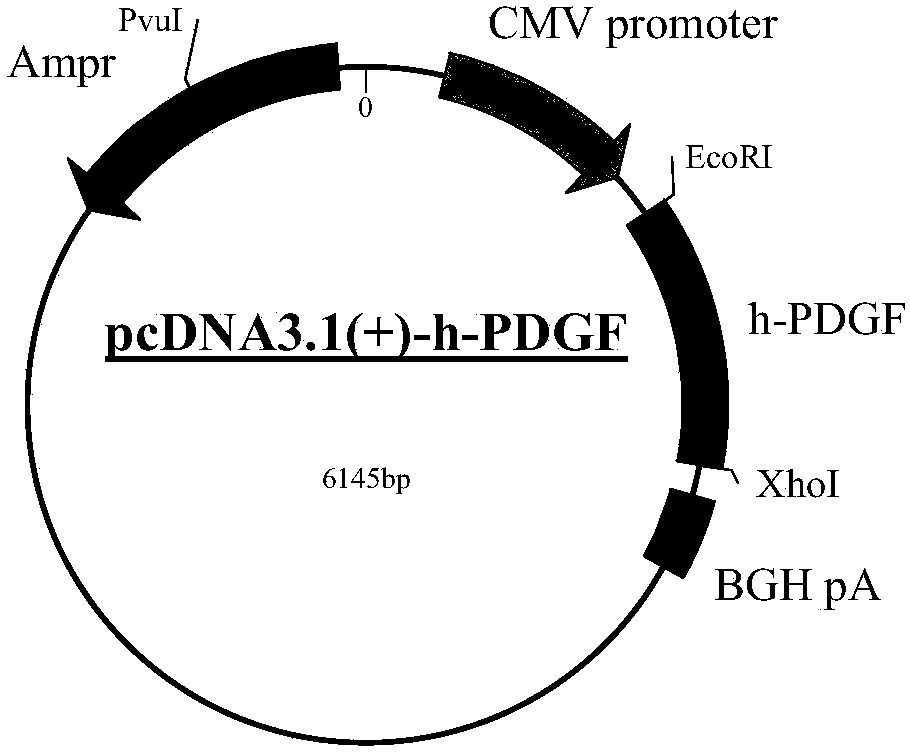Construction method and application of PDGF-BB transgenic mouse spinal cord transaction model
A PDGF-BB, transgenic mouse technology, applied to other methods of inserting foreign genetic materials, genetic engineering, chemical instruments and methods, etc., can solve the problem of unclear specific effects and underlying mechanisms, etc.
- Summary
- Abstract
- Description
- Claims
- Application Information
AI Technical Summary
Problems solved by technology
Method used
Image
Examples
Embodiment 1
[0087] Example 1 Construction of PDGF-BB high expression transgenic mouse model
[0088] The PDGF-BB overexpression transgenic mice were constructed by transgenic technology, and the positive transgenic mice were identified by PCR. The strains with the highest and lowest expression of PDGF-BB were screened out by RT-PCR and Western blot techniques, and a mouse model with stable overexpression was established.
[0089] 1) Construction of PDGF-BB overexpression transgenic fragments, the construction method includes the following experimental steps:
[0090] 1.1) PCR cloning amplifies the open reading frame (ORF) of the target gene PDGF-BB, and the amplification primer sequence is as follows:
[0091] The upstream primer is 5'CGCTCCTTTGATGATCTCC 3', the nucleotide sequence of which is shown in SEQ ID NO.1;
[0092] The downstream primer is 5'TTGGTGCGGTCTATGAGG 3', its nucleotide sequence is shown in SEQ ID NO.2, and the target fragment is 230bp;
[0093] 1.2) pcDNA3.1(+)-h-PDGF...
Embodiment 2
[0121] Example 2 Construction of PDGF-BB Low Expression Transgenic Mouse Model
[0122] Using transgenic technology to construct transgenic mice with low expression of PDGF-BB, positive transgenic mice were identified by PCR, and the strains with the highest and lowest expression of PDGF-BB were screened out by RT-PCR and Western blot technology, and a mouse model with stable low expression was established.
[0123] 1) Construct a transgenic fragment with low expression of PDGF-BB, and identify the efficiency of PDGF-BB expression inhibition in vitro, including the following experimental steps:
[0124] 1.1) Construction of CMV-EmGFP-siRNA-PDGF-BB low-expression transgene fragment. like Image 6 As shown, the silent expression vector CMV-EmGFP-siRNA-PDGF-BB was purchased from Invitrogen, and the software provided by the company's website was used to target the target gene PDGF-BB (PDGFB platelet-derived growth factor beta polypeptide, GeneID: NM_011057) The point is (CGGCTGC...
Embodiment 3
[0138] Example 3 Establishment of a Transgenic Mouse Spinal Cord Transection Model
[0139] Using the obtained transgenic mouse model, establish a mouse model of total transection injury of the spinal cord. The specific steps include: anesthetize the transgenic mouse, fix it in the prone position, prepare the skin, cut the back skin, fascia and muscle layer, and remove the lamina with a rongeur , to expose the T9-T11 segmental spinal cord layer by layer, transect at the T10 level, and use a string with a diameter of about 1 mm to pass through the injury plane to ensure that the spinal cord is completely transected. After the operation is successful, the tail and limbs of the mouse can be observed to twitch. After the operation, the bleeding was stopped and sutured layer by layer. Mice whose spinal cord was successfully transected at T10 level showed postoperative paralysis of both lower limbs, no spontaneous movement, disappearance of urination radiation, and disappearance of...
PUM
| Property | Measurement | Unit |
|---|---|---|
| Diameter | aaaaa | aaaaa |
Abstract
Description
Claims
Application Information
 Login to View More
Login to View More - R&D
- Intellectual Property
- Life Sciences
- Materials
- Tech Scout
- Unparalleled Data Quality
- Higher Quality Content
- 60% Fewer Hallucinations
Browse by: Latest US Patents, China's latest patents, Technical Efficacy Thesaurus, Application Domain, Technology Topic, Popular Technical Reports.
© 2025 PatSnap. All rights reserved.Legal|Privacy policy|Modern Slavery Act Transparency Statement|Sitemap|About US| Contact US: help@patsnap.com



